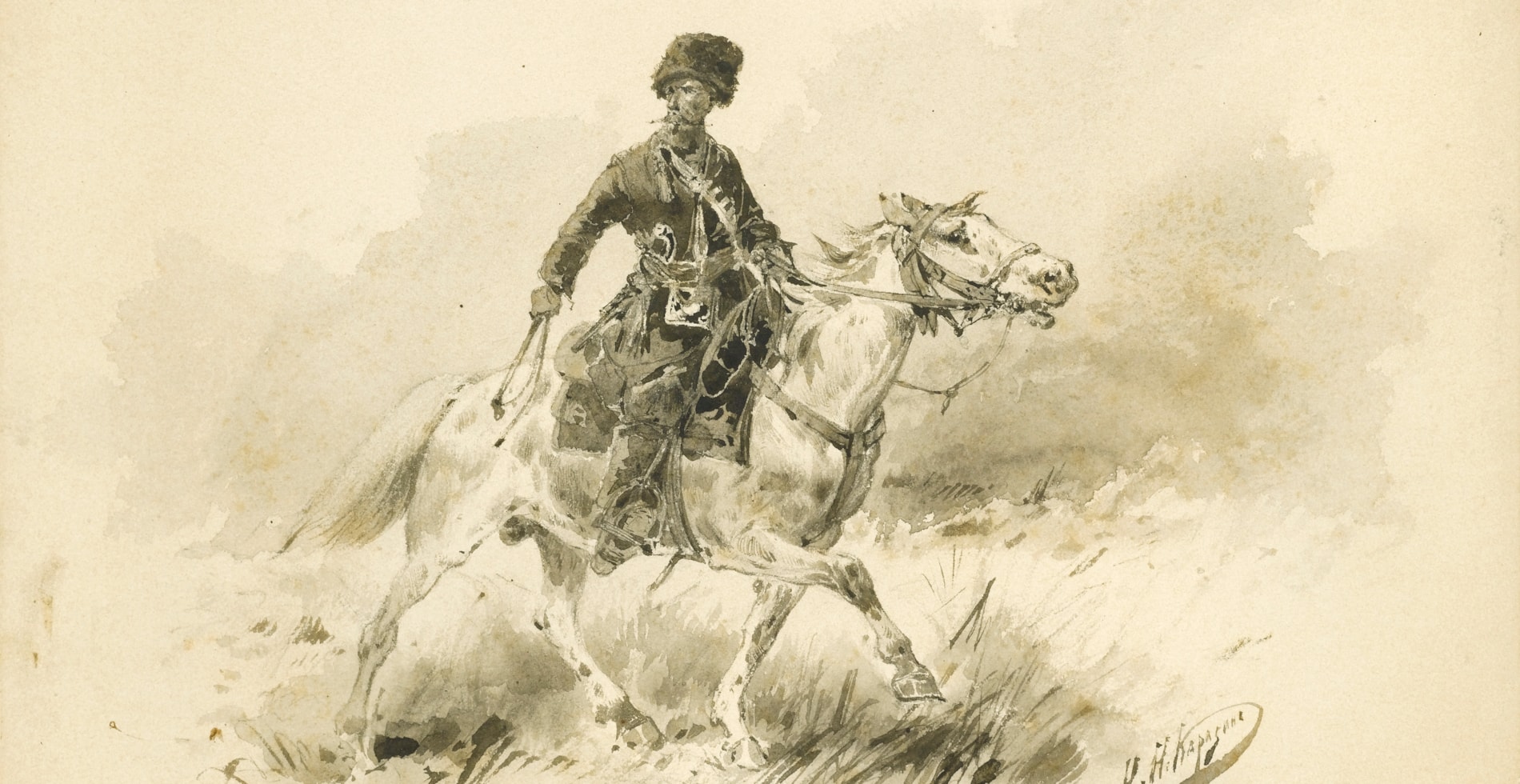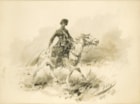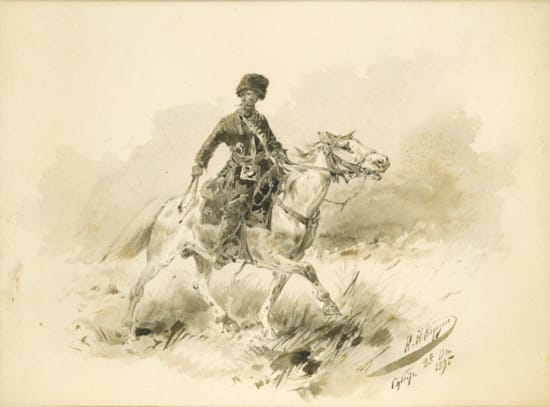ikolai Nikolaevich Karazin
(Kharkov 1842 - Gatchina 1908)
Cossack on Horseback
signed and inscribed in Cyrillic and dated '28 [Oct ]1895' (lower right)
ink and wash on paper
28.5 x 38 cm (11¼ x 15 in)
A fierce Cossack soldier, with a proud posture and stern gaze, confidently rides across a moor. He wears a fleece hat and long coat, typical of the Cossack uniform. One hand holds the horse’s reins, while his other clasps a whip; a gun is strapped to his side. Nikolai Nikolaevich Karazin commands full focus on the rider and steed by omitting any other background details apart from a few marks hinting at a grassy surrounding. Cossack on Horseback is skillfully executed and the work is impressively detailed. Through layers of delicate light and dark wash, Karazin builds his subjects and imbues them with character. The horse moves with a pronounced gait, a slight expression of nervousness in its eyes. This contrasts with the sharp features of its rider. The Cossack’s eyes are intense and his long face distinguished, a feature accentuated by his finely groomed moustache. Closer inspection of his face reveals the meticulous and intricate work of Karazin’s hand, characteristic of this composition as a whole.
The Cossacks were a proud community whose origins lie in the Ukraine. They were greatly admired for their equestrian talents, which saw them recruited into the Russian military as cavalry units. The term ‘Cossack’ comes via the French word Cosaque, which originated from the Turkish qazaq, meaning ‘adventurer’ or ‘free man’, and these characteristics are certainly evoked in Cossack on Horseback.
Karazin worked as a writer and a painter but prior to this, he served in the military and it is from these experiences that he was able to produce such spirited works as the present example. He was born to a family of scientists: his grandfather was an intellectual and founder of Kharkiv University while his father was an inventor. Karazin graduated from the Moscow cadet school in 1862 and from 1865 to 1867 he studied at the Imperial Academy of Art in St. Petersburg. His military service saw him participate in the campaign against the January Uprising in Poland (1864) and in the expeditions in Turkestan (1864-1870). In 1871 Karazin retired from military service but continued to see action working as a military correspondent and illustrator during the Russo-Turkish War (1877-1878). A prolific traveller, Karazin explored central Asia on a scientific expedition and journeyed to India, Egypt and Italy, among others.
Karazin’s time as an illustrator and military correspondent saw him progress into a career as an adventure and ethnographic story writer. During this time he wrote From North to South, a children’s book chronicling the journey of a crane migrating from the Ostashkov swamps to the Upper Nile, which he illustrated himself. These illustrations seem to have led Karazin into a life of painting, where he began to paint many scenes of battles and military campaigns in Turkestan. Karazin’s bold, large scale paintings such as Russian Troops Taking Samarkand, (1868, Private Collection) and his exquisite, meticulous illustrations such as Cossack on Horseback reveal the subject matter for which he became most renowned. In both genres he demonstrates a sensitive and intricate touch, a controlled command of his materials and an affinity with his subject, superbly exemplified in the refined nature of the present work.
He became an Academician of the Imperial Academy of Arts in 1904, and passed away four years later in Gatchina.
A fierce Cossack soldier, with a proud posture and stern gaze, confidently rides across a moor. He wears a fleece hat and long coat, typical of the Cossack uniform. One hand holds the horse’s reins, while his other clasps a whip; a gun is strapped to his side. Nikolai Nikolaevich Karazin commands full focus on the rider and steed by omitting any other background details apart from a few marks hinting at a grassy surrounding. Cossack on Horseback is skillfully executed and the work is impressively detailed. Through layers of delicate light and dark wash, Karazin builds his subjects and imbues them with character. The horse moves with a pronounced gait, a slight expression of nervousness in its eyes. This contrasts with the sharp features of its rider. The Cossack’s eyes are intense and his long face distinguished, a feature accentuated by his finely groomed moustache. Closer inspection of his face reveals the meticulous and intricate work of Karazin’s hand, characteristic of this composition as a whole.
The Cossacks were a proud community whose origins lie in the Ukraine. They were greatly admired for their equestrian talents, which saw them recruited into the Russian military as cavalry units. The term ‘Cossack’ comes via the French word Cosaque, which originated from the Turkish qazaq, meaning ‘adventurer’ or ‘free man’, and these characteristics are certainly evoked in Cossack on Horseback.
Karazin worked as a writer and a painter but prior to this, he served in the military and it is from these experiences that he was able to produce such spirited works as the present example. He was born to a family of scientists: his grandfather was an intellectual and founder of Kharkiv University while his father was an inventor. Karazin graduated from the Moscow cadet school in 1862 and from 1865 to 1867 he studied at the Imperial Academy of Art in St. Petersburg. His military service saw him participate in the campaign against the January Uprising in Poland (1864) and in the expeditions in Turkestan (1864-1870). In 1871 Karazin retired from military service but continued to see action working as a military correspondent and illustrator during the Russo-Turkish War (1877-1878). A prolific traveller, Karazin explored central Asia on a scientific expedition and journeyed to India, Egypt and Italy, among others.
Karazin’s time as an illustrator and military correspondent saw him progress into a career as an adventure and ethnographic story writer. During this time he wrote From North to South, a children’s book chronicling the journey of a crane migrating from the Ostashkov swamps to the Upper Nile, which he illustrated himself. These illustrations seem to have led Karazin into a life of painting, where he began to paint many scenes of battles and military campaigns in Turkestan. Karazin’s bold, large scale paintings such as Russian Troops Taking Samarkand, (1868, Private Collection) and his exquisite, meticulous illustrations such as Cossack on Horseback reveal the subject matter for which he became most renowned. In both genres he demonstrates a sensitive and intricate touch, a controlled command of his materials and an affinity with his subject, superbly exemplified in the refined nature of the present work.
He became an Academician of the Imperial Academy of Arts in 1904, and passed away four years later in Gatchina.





 contact
contact contact
contact +44 20 7313 8040
+44 20 7313 8040









